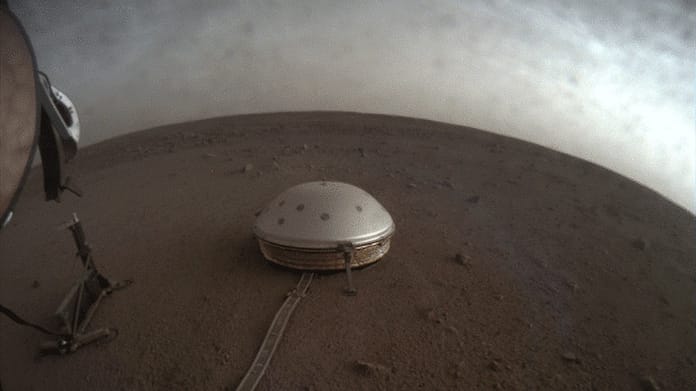
The seismometer of the Mars Insight probe. (Photo: NASA/JPL-Caltech)
Liquid core, liquid mantle, thin crust – thanks to data from the Mars Insight probe, researchers inside have for the first time evidence of the interior of Mars.
Scientists have known only about 100 years ago how the Earth formed in the interior. Mars is only the second planet where such insight into the internal structure has been achieved. This is made possible thanks to the Mars Insight probe, which has been listening for earthquakes on the surface of the Red Planet since the end of 2018. It is said that more than 700 earthquakes have been measured so far. An image of the planet can be created using seismic waves. at Three studies The results are now processed. Conclusion: Mars is quite similar to Earth in its interior, but shows greater differences.
Insight: Mars has a liquid heart
Mars, like Earth, has a liquid core on the inside – at least on the outside. It has not yet been possible to determine whether the core of Mars, like that of Earth, is intrinsically solid. In any case, the size of the core is 1,830 kilometers in radius. The Earth’s core is twice the size of its radius of about 3,500 km. However, the radius of Mars is half the radius of Earth. According to Insight data, the liquid lithosphere layer covering it is at least 1,500 kilometers thick br.de . reports. Unlike Earth, the mantle consists of only one layer of rock.
When it comes to Mars’ crust, scientists still don’t fully agree on whether it consists of two or three layers. Depending on the situation, the thickness of the Martian crust is 20 or 39 kilometers at the point where the Mars probe is located. Compared to Earth’s continental crust, Mars’ crust would be very thin if there were only two layers, according to geologist Brigitte Knappmayr-Endron of the University of Cologne, which One of the three studies was involved. In general, the thickness of the crust on Mars is said to be between 24 and 72 kilometers.
There are no tectonic plates, but earthquakes nonetheless
According to the researchers, it is now clear that Mars, like Earth, was initially a glowing liquid. However, the layered structure is somewhat different. In addition, it is unlikely that Mars has plate tectonics primarily responsible for earthquakes. Instead, Martian earthquakes — less powerful — arise because Mars’ crust has folds and fractures and continues to shrink as the planet cools. Additional seismic measurements should help clarify more questions about Mars, such as why its magnetic field is lost.







